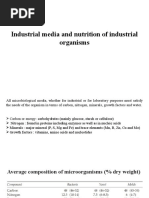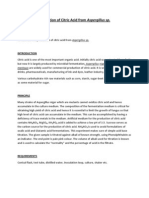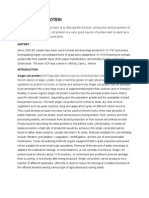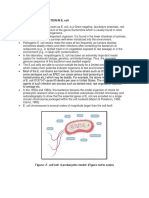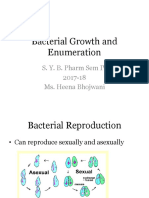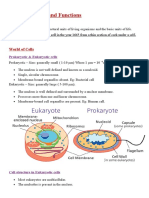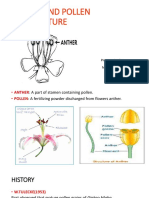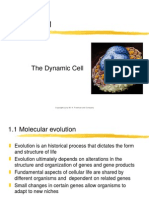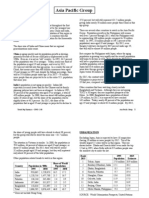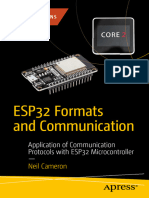Neurospora - Wikipedia
Neurospora - Wikipedia
Uploaded by
koiCopyright:
Available Formats
Neurospora - Wikipedia
Neurospora - Wikipedia
Uploaded by
koiCopyright
Available Formats
Share this document
Did you find this document useful?
Is this content inappropriate?
Copyright:
Available Formats
Neurospora - Wikipedia
Neurospora - Wikipedia
Uploaded by
koiCopyright:
Available Formats
Neurospora - Wikipedia
1 3
https://en.wikipedia.org/wiki/Neurospora
Neurospora
From Wikipedia, the free encyclopedia
Neurospora is a genus of Ascomycete fungi. The genus name, meaning
"nerve spore" refers to the characteristic striations on the spores that
resemble axons.
The best known species in this genus is Neurospora crassa, a common
model organism in biology. Neurospora intermedia var. oncomensis is
believed to be the only mold belonging to Neurospora which is used in
food production (to make oncom).[1]
Contents
1
2
3
4
5
6
7
Characteristics
Systematics
Neurospora as model organisms
Sexual reproduction
See also
References
External links
Characteristics
Neurospora species are molds with broadly spreading colonies, with
abundant production of ascomata. Ascomata are superficial or immersed,
perithecial and ostiolate or cleistothecial and non-ostiolate, hairy or
glabrous, dark coloured. Peridium membranaceous, asci cylindrical,
clavate or subspherical, with a persistent or evanescent wall, usually with a
thickened and non-amyloid annular structure at the apex, usually 8-spored.
Ascospores broadly fusiform, ellipsoidal, or nearly spherical, unicellular,
hyaline to yellowish brown or olive-brown, becoming dark and opaque at
maturity, ascospore wall with longitudinal ribs or pitted, occasionally
nearly smooth, 12 (but rarely up to 12) germ pores disposed at the ends of
the ascospores, gelatinous sheaths or appendages are absent. Anamorphs
are known in only a relatively small number of species, which belong to
the fungi imperfecti genus Chrysonilia. The type species of the genus is
Neurospora sitophila Shear[2]
Systematics
The former genera Gelasinospora and Neurospora are closely related and
not resolved as monophyletic groups,[3] thus the former genus is nowadays
included in Neurospora.[2]
Neurospora as model organisms
Neurospora
Scientific classification
Kingdom:
Fungi
Phylum:
Ascomycota
Subphylum: Pezizomycotina
Class:
Ascomycetes
Order:
Sordariales
Family:
Sordariaceae
Genus:
Neurospora
Shear & B.O.
Dodge, 1927
Species
N. africana
N. bonaerensis
N. brevispora
N. caffera
N. calospora
N. cerealis
N. crassa
N. cratophora
N. dictyophora
N. discreta
N. dodgei
N. himalayensis
N. hippopotama
N. indica
N. intermedia
N. inversa
N. kobi
N. lineolata
N. longispora
N. novoguineensis
N. pannonica
N. pseudocalospora
N. pseudoreticulata
N. reticulata
N. sitophila
N. tetrasperma
Synonyms
18.10.2016 13:38
Neurospora - Wikipedia
2 3
Neurospora is widely used in genetics as a model organism (especially N.
crassa) because it is quickly reproducing, is easy to culture, [4] and can
survive on minimal media (inorganic salts, glucose, water and biotin in
agar).
https://en.wikipedia.org/wiki/Neurospora
Gelasinospora
Anixiella
The first studies of sexual reproduction in Neurospora were made by B. O. Dodge. Neurospora was later
used by George Wells Beadle and Edward Lawrie Tatum in X-ray mutation experiments in order to discover
mutants that would differ in nutritional requirements. The results of their experiments led them to the one
gene-one enzyme hypothesis, in which they postulated that every enzyme was encoded with its own gene.
Research with Neurospora is reported semi-annually at the Neurospora Meeting at Asilomar, California,
coordinated by the Fungal Genetics Stock Center. Mutant and wild-type strains of Neurospora are available
from the FGSC. The FGSC also publishes the Fungal Genetics Reports.
Important people in Neurospora research:
Bernard Ogilvie Dodge (18721960)[4]
George Beadle (Nobel Prize in Physiology or Medicine, 1958)
Edward Tatum (Nobel Prize in Physiology or Medicine, 1958)
Esther Lederberg[5][6][7]
Norman Giles[7]
David Perkins
Robert Metzenberg
Norman Horowitz
Herschel Mitchell[8]
Mary B. Mitchell[9]
Sexual reproduction
In the heterothallic species Neurospora crassa, interaction of strains of opposite mating is necessary for the
occurrence of sexual reproduction and the production of ascospores by meiosis. The genus Neurospora also
includes homothallic species in which a single individual can undergo self-fertilization leading to meiosis
and sexual reproduction. Neurospora africana is an example of such a species.[10][11] Because heterothallic
species necessarily undergo some degree of outcrossing they may benefit from the masking of deleterious
recessive alleles that express in the dikaryon or diploid stage and/or from increased genetic variability. In
contrast, homothallic species do not outcross and do not experience these benefits. However, both heteroand homothallic species derive the benefits of meiosis that include the removal of stress-induced DNA
damages by homologous recombinational repair, and the formation of stress-resistant ascospores.
See also
Ascomycota
Ascospore
Genetic variability
Heterothallic
Homologous recombination
Homothallism
Mating type
Meiosis
Neurospora crassa
18.10.2016 13:38
Neurospora - Wikipedia
3 3
https://en.wikipedia.org/wiki/Neurospora
References
1. Ho C.C. 1986. Identity and characteristics of Neurospora intermedia responsible for oncom fermentation in
Indonesia. Food Microbiology 3(2):115-132 (April 1986).
2. Garcia, D.; et al. (2004). "A synopsis and re-circumscription of Neurospora (syn. Gelasinospora) based on
ultrastructural and 28S rDNA sequence data". Mycol. Res. 108 (10): 11191142.
doi:10.1017/s0953756204000218.
3. Cai, L.; et al. (2006). ", Phylogenetic investigations of Sordariaceae based on multiple gene sequences and
morphology". Mycological Research. 110: 137150. doi:10.1016/j.mycres.2005.09.014.
4. Dodge, B. O. "Crossing hermaphroditic races of Neurospora". Mycologia. 24 (1): 713. doi:10.2307/3753727.
5. Zimmer, E. M., August 1946, "MUTANT STRAINS OF NEUROSPORA DEFICIENT IN
PARA-AMINOBENZOIC ACID", MA Thesis, Stanford University
6. Hollaender, A., Sansome E. R., Zimmer, E., Demerec, M., April 1945, "Quantitative Irradiation Experiments with
Neurospora crassa. II. Ultraviolet Irradiation", American Journal of Botany 32(4):226-235 Also: "Quantitative
effects of radiation on mutation production in Neurospora crassa", Records of the Genetics Society of America,
Number Thirteen, 1944
7. Giles, N. H. Jr., Lederberg, E. Z., March 1948, "Induced reversions of biochemical mutants in Neurospora crassa",
American Journal of Botany 35(3):150-157
8. Mitchell HK, Nyc JF (January 1948). "Hydroxyanthranilic Acid as a Precursor of Nicotinic Acid in Neurospora".
Proc. Natl. Acad. Sci. U.S.A. 34 (1): 15. doi:10.1073/pnas.34.1.1. PMC 1062899 . PMID 16588774.
9. Mitchell MB (April 1955). "ABERRANT RECOMBINATION OF PYRIDOXINE MUTANTS OF Neurospora".
Proc. Natl. Acad. Sci. U.S.A. 41 (4): 21520. doi:10.1073/pnas.41.4.215. PMC 528059 . PMID 16589648.
10. Glass NL, Smith ML (August 1994). "Structure and function of a mating-type gene from the homothallic species
Neurospora africana". Mol. Gen. Genet. 244 (4): 4019. doi:10.1007/bf00286692. PMID 8078466.
11. Metzenberg RL, Glass NL (February 1990). "Mating type and mating strategies in Neurospora". BioEssays. 12
(2): 539. doi:10.1002/bies.950120202. PMID 2140508.
External links
[1] (http://www.fgsc.net) Fungal Genetics Stock Center
[2] (http://www.fgsc.net/asilmtg.html) Neurospora Meeting website
Neurospora strains (http://www.fgsc.net/ncrassa.html) at the FGSC
Neurospora genome projects (http://www.fgsc.net/Neurospora/neuros.htm)
Fungal Cell Biology Group (http://129.215.156.68/index.html) at University of Edinburgh, UK.
Website includes many movies and images of Neurospora.
[3] (http://www.fgsc.net/FungalGeneticsReports.htm) Fungal Genetics Reports
[4] (http://www.benchfly.com/blog/the-almighty-fungi-the-revolutionary-neurospora-crassa/)
Montenegro-Montero A. (2010) "The Almighty Fungi: The Revolutionary Neurospora crassa". A
historical view of the many contributions of this organism to molecular biology.
[5] (http://www.broad.mit.edu/annotation/genome/neurospora/) Neurospora crassa genome
Retrieved from "https://en.wikipedia.org/w/index.php?title=Neurospora&oldid=732170876"
Categories: Sordariales
This page was last modified on 30 July 2016, at 03:20.
Text is available under the Creative Commons Attribution-ShareAlike License; additional terms may
apply. By using this site, you agree to the Terms of Use and Privacy Policy. Wikipedia is a registered
trademark of the Wikimedia Foundation, Inc., a non-profit organization.
18.10.2016 13:38
You might also like
- Unit 2 - Molds MorphologyDocument11 pagesUnit 2 - Molds MorphologyMinh DuyNo ratings yet
- Essential Applications of Musculoskeletal Ultrasound in Rheumatology-Richard J. Wakefield, Maria Antonietta D'AgostinoDocument358 pagesEssential Applications of Musculoskeletal Ultrasound in Rheumatology-Richard J. Wakefield, Maria Antonietta D'AgostinoCristina PavelNo ratings yet
- Dark Field MicrosDocument1 pageDark Field MicrosPatrick ManriqueNo ratings yet
- Industrial Production of Glutamic AcidDocument4 pagesIndustrial Production of Glutamic AcidAkash RoyNo ratings yet
- Chapter 4 - Explant Preparation - 2013 - Plant Tissue Culture PDFDocument7 pagesChapter 4 - Explant Preparation - 2013 - Plant Tissue Culture PDFLuis BermudezNo ratings yet
- LESSON 1.1 - Food As Substrate For Microbes - Understanding Growth FactorsDocument32 pagesLESSON 1.1 - Food As Substrate For Microbes - Understanding Growth Factorsrivi.villanueva.sjcNo ratings yet
- 2.industrial Media and Nutrition of Industrial OrganismsDocument38 pages2.industrial Media and Nutrition of Industrial OrganismsM M BillahNo ratings yet
- Trancegenic PlantsDocument17 pagesTrancegenic PlantsKalyani Sawarkar SatoneNo ratings yet
- XII - Onion Root Tip ExptDocument6 pagesXII - Onion Root Tip Exptkavikiran100% (2)
- Edible Vaccine: BY:-Rewat PD Kafle SANN Int'l College KathmanduDocument26 pagesEdible Vaccine: BY:-Rewat PD Kafle SANN Int'l College KathmanduBradley BridgesNo ratings yet
- Insensitivity To Growth Inhibitory SignalsDocument71 pagesInsensitivity To Growth Inhibitory SignalsDR. ISHITA SINGHALNo ratings yet
- Protein Assay by Bradford MethodDocument4 pagesProtein Assay by Bradford MethodChadby GraNaNoNo ratings yet
- Alkaline Phosphatase and LigasesDocument18 pagesAlkaline Phosphatase and LigasessathyaNo ratings yet
- CryopreservationDocument18 pagesCryopreservationgaurav saxenaNo ratings yet
- Genei Dna Fingerprinting Teaching Kit ManualDocument10 pagesGenei Dna Fingerprinting Teaching Kit ManualHemant KawalkarNo ratings yet
- Bioleaching of Gold and SilverDocument5 pagesBioleaching of Gold and SilverOm kesarwaniNo ratings yet
- Auto RadiographyDocument15 pagesAuto RadiographyShelvy SNo ratings yet
- Pyrogen TestDocument15 pagesPyrogen TestSrijonNo ratings yet
- Mixed Lymphocyte Culture / Reaction (MLC / MLR)Document2 pagesMixed Lymphocyte Culture / Reaction (MLC / MLR)Muthi KhairunnisaNo ratings yet
- Gel ElectrophoresisDocument18 pagesGel ElectrophoresisFaiza RashidNo ratings yet
- Production, Purification and Product Recovery of StreptomycinDocument20 pagesProduction, Purification and Product Recovery of StreptomycinDixya ShresthaNo ratings yet
- An Introduction To Cloning and Recombinant DNADocument29 pagesAn Introduction To Cloning and Recombinant DNAJon FaizalNo ratings yet
- DNA Estimation Using DPA Reaction PDFDocument5 pagesDNA Estimation Using DPA Reaction PDFAnsh KumarNo ratings yet
- Detection and Isolation of Mutants By: Replica-Plating TechniqueDocument23 pagesDetection and Isolation of Mutants By: Replica-Plating TechniquePUSHPALATHA.TNo ratings yet
- Environmental Microbiology NotesDocument183 pagesEnvironmental Microbiology NotesEsai Kanaga YadavNo ratings yet
- Estimation of Citric Acid From Aspergillus SPDocument4 pagesEstimation of Citric Acid From Aspergillus SPDinithiDahanayake100% (3)
- 3 Exercise Metachromatic GranulesDocument15 pages3 Exercise Metachromatic Granulesharini meenakshiNo ratings yet
- Single Cell ProteinDocument15 pagesSingle Cell Proteinsharma28No ratings yet
- Stem Cells - Sources, Characteristics, Types, Uses - Developmental Biology - Microbe NotesDocument5 pagesStem Cells - Sources, Characteristics, Types, Uses - Developmental Biology - Microbe NotesAmar Kant JhaNo ratings yet
- Organ Culture: FeaturesDocument3 pagesOrgan Culture: FeaturesAlphy ThomasNo ratings yet
- Genome Organization in E. ColiDocument7 pagesGenome Organization in E. ColiAman KhanNo ratings yet
- Practical - Turbidimetric MethodsDocument9 pagesPractical - Turbidimetric MethodsProbioticsAnywhere100% (1)
- Transplantation Immunology S1Document23 pagesTransplantation Immunology S1emelda sugiartiNo ratings yet
- Plant Tissue CultureDocument40 pagesPlant Tissue CultureSathish SizzyNo ratings yet
- Sterilization of MediumDocument18 pagesSterilization of MediumGuleRia ShiVani100% (1)
- Types of Biofertilizers and Importance: I. N FixersDocument12 pagesTypes of Biofertilizers and Importance: I. N FixersshubhamNo ratings yet
- Bacterial Growth and Enumeration PDFDocument42 pagesBacterial Growth and Enumeration PDFHeena BhojwaniNo ratings yet
- Genei: Bacterial Gene Expression Teaching Kit ManualDocument12 pagesGenei: Bacterial Gene Expression Teaching Kit Manualhar2dikNo ratings yet
- Cell - Structure and Functions: World of CellsDocument5 pagesCell - Structure and Functions: World of CellsPriyanshu Priyadarshi MeherNo ratings yet
- Anther and Pollen Culture: Presentation by Mantesh - SM PALM 7018Document23 pagesAnther and Pollen Culture: Presentation by Mantesh - SM PALM 7018Creative Mind100% (1)
- Ice Minus ExperimentDocument10 pagesIce Minus ExperimentrgvendranNo ratings yet
- Ms Media PDFDocument7 pagesMs Media PDFtinNo ratings yet
- Bacteriocin Purification Research ProposalDocument7 pagesBacteriocin Purification Research ProposalThanh Nguyen LeNo ratings yet
- Biological Search EnginesDocument3 pagesBiological Search EnginesShubham PawadeNo ratings yet
- StainigDocument38 pagesStainigyuppie_raj2175No ratings yet
- ExtremophilesDocument7 pagesExtremophilesStephen MooreNo ratings yet
- Study Different Stages of Mitosis in Onion Root TipDocument19 pagesStudy Different Stages of Mitosis in Onion Root TipfatemaNo ratings yet
- Chapter01 The Dynamic CellDocument14 pagesChapter01 The Dynamic Cellnikmah nuur rochmah0% (1)
- TRANSGENIC ANIMALS PDocument12 pagesTRANSGENIC ANIMALS PNehaNo ratings yet
- Industrial Production of InsulinDocument20 pagesIndustrial Production of Insulinعبدالمحسن علي ENo ratings yet
- Advantages of Solid State Fermentation Over Submerged FermentationDocument32 pagesAdvantages of Solid State Fermentation Over Submerged Fermentationtelangsachin12No ratings yet
- 6) PPT On Lactate DehydrogenaseDocument8 pages6) PPT On Lactate DehydrogenaseSubha MaheswariNo ratings yet
- Phyllotaxy of LeafDocument3 pagesPhyllotaxy of LeafJanine TugononNo ratings yet
- Serum Free MediaDocument8 pagesSerum Free MediaVejerla PriyankaNo ratings yet
- 06 GastrulationtxtDocument38 pages06 GastrulationtxtHafidzul HalimNo ratings yet
- Plant Biotechnology (Tissue Culture)Document11 pagesPlant Biotechnology (Tissue Culture)Hewa HusenNo ratings yet
- University of Dar Es SalaamDocument11 pagesUniversity of Dar Es SalaamWILBERFORCENo ratings yet
- Animal BiotechnologyDocument143 pagesAnimal BiotechnologyDaniel Pulido Rojas100% (1)
- Physiology of BacteriaDocument150 pagesPhysiology of BacteriaМохіт Кумар Ямпаті100% (1)
- Cyanobacteria Economic ImportanceDocument15 pagesCyanobacteria Economic ImportanceKumail IslamianNo ratings yet
- Quality (Philosophy) - WikipediaDocument2 pagesQuality (Philosophy) - WikipediakoiNo ratings yet
- NyoDocument1 pageNyokoiNo ratings yet
- Property (Philosophy) - WikipediaDocument3 pagesProperty (Philosophy) - WikipediakoiNo ratings yet
- Comics - WikipediaDocument16 pagesComics - WikipediakoiNo ratings yet
- Maus - WikipediaDocument20 pagesMaus - WikipediakoiNo ratings yet
- Knowledge - WikipediaDocument8 pagesKnowledge - WikipediakoiNo ratings yet
- Milos - WikipediaDocument9 pagesMilos - WikipediakoiNo ratings yet
- Phylum - WikipediaDocument9 pagesPhylum - WikipediakoiNo ratings yet
- Patria Disaster - WikipediaDocument5 pagesPatria Disaster - WikipediakoiNo ratings yet
- Termoli - WikipediaDocument4 pagesTermoli - WikipediakoiNo ratings yet
- Ascomycota - WikipediaDocument14 pagesAscomycota - WikipediakoiNo ratings yet
- Taxonomic Rank - WikipediaDocument11 pagesTaxonomic Rank - WikipediakoiNo ratings yet
- Neapolitan Language - WikipediaDocument10 pagesNeapolitan Language - WikipediakoiNo ratings yet
- Cocco Bill - WikipediaDocument2 pagesCocco Bill - WikipediakoiNo ratings yet
- Benito Jacovitti - WikipediaDocument2 pagesBenito Jacovitti - WikipediakoiNo ratings yet
- Luca Salvagno - WikipediaDocument1 pageLuca Salvagno - WikipediakoiNo ratings yet
- Two-Phase Electric Power - WikipediaDocument3 pagesTwo-Phase Electric Power - WikipediaJai NairNo ratings yet
- The Position of Women in The Creation ADocument53 pagesThe Position of Women in The Creation AEmad Abd ElnorNo ratings yet
- Product List: Rock SupplyDocument1 pageProduct List: Rock Supplyমোহাম্মদ তৌফিকNo ratings yet
- Aac LayoutDocument1 pageAac Layoutveem riveraNo ratings yet
- Assignment 2: Accepted AnswersDocument10 pagesAssignment 2: Accepted AnswersxlntyogeshNo ratings yet
- Turfcat T628D 2WDDocument124 pagesTurfcat T628D 2WDRick HareNo ratings yet
- Siemon Tera E6 Cable Spec SheetDocument2 pagesSiemon Tera E6 Cable Spec SheetAdrian Gamboa MarcellanaNo ratings yet
- Multicom Product Catalog PDFDocument70 pagesMulticom Product Catalog PDFJack ElhaqNo ratings yet
- AC500-eCo Kit Starter 2CDC125088L0202Document2 pagesAC500-eCo Kit Starter 2CDC125088L0202Multidrive BauruNo ratings yet
- FDI History IndiaDocument7 pagesFDI History IndiaAshutosh TulsyanNo ratings yet
- Top 10 PCB Design ChecksDocument27 pagesTop 10 PCB Design ChecksRalf Conrado ScodelerNo ratings yet
- Homework 4: Physics 715 - Statistical Mechanics Professor Michael Ramsey-Musolf April 12, 2010Document18 pagesHomework 4: Physics 715 - Statistical Mechanics Professor Michael Ramsey-Musolf April 12, 2010Rubens MarioNo ratings yet
- Menu Good Folks - Baru - Set Night Menu - Jempol Foto N Text Menu N Favorite TagDocument13 pagesMenu Good Folks - Baru - Set Night Menu - Jempol Foto N Text Menu N Favorite TagIvan Christian SaputraNo ratings yet
- Physics SBK11Document208 pagesPhysics SBK11Yabo Cumar100% (1)
- Analysis RavishankarDocument196 pagesAnalysis RavishankarKavya sriNo ratings yet
- Pos. Quantity Part No. 01 2 PC Drive Package (Completion) PHF002TKF87DRN160M4/BE20/HR/TF/AK8W Links To DocumentationDocument3 pagesPos. Quantity Part No. 01 2 PC Drive Package (Completion) PHF002TKF87DRN160M4/BE20/HR/TF/AK8W Links To Documentationluckybhat47No ratings yet
- AGP Population TrendsDocument36 pagesAGP Population TrendsPatrick AdamsNo ratings yet
- Neil Cameron - ESP32 Formats and CommunicationDocument657 pagesNeil Cameron - ESP32 Formats and CommunicationSai Krishna K VNo ratings yet
- Coordinate Geometry Study Material Class 10 MathsDocument3 pagesCoordinate Geometry Study Material Class 10 MathsdvpjalNo ratings yet
- Saleem 2024 PolicyDocument7 pagesSaleem 2024 PolicyvictskoolNo ratings yet
- Billions Club - How To Pass A Trading ChallengeDocument58 pagesBillions Club - How To Pass A Trading ChallengeamanipaularthurNo ratings yet
- Fiche Technique Film FUJI DI-HLDocument2 pagesFiche Technique Film FUJI DI-HLIchraq Nouar100% (1)
- Englert - 1997 - Time Reversal Symmetry and Humpty-DumptyDocument2 pagesEnglert - 1997 - Time Reversal Symmetry and Humpty-Dumptymikolaj_bugzillaNo ratings yet
- Brockhampton - Rex Orange County - Billie Eilish: Spring 2019Document28 pagesBrockhampton - Rex Orange County - Billie Eilish: Spring 2019Felice Cabral0% (1)
- Crime Detection and InvestigationDocument60 pagesCrime Detection and InvestigationQayes Al-QuqaNo ratings yet
- Module Lifting Supervisor (BI)Document170 pagesModule Lifting Supervisor (BI)shahrul azharNo ratings yet
- Let Me Help You HealDocument41 pagesLet Me Help You HealLala MelandroNo ratings yet
- How To Control ShrikageDocument2 pagesHow To Control Shrikagestylish eagleNo ratings yet
- 30 2 PDFDocument43 pages30 2 PDFBoonme ChinnaboonNo ratings yet






